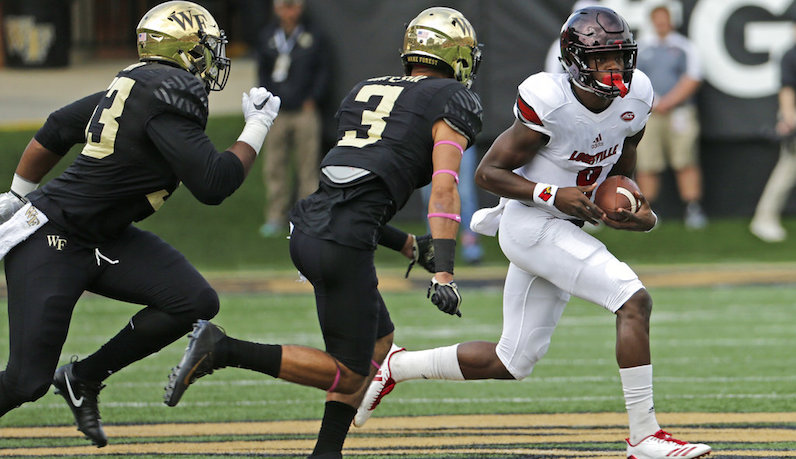Almost all the public and media attention last week was focused on the season-ending injury to Greg Dortch, Wake Forest’s outstanding receiver. That certainly made sense, considering Dortch was coming off a dominant, four-touchdown showing against Louisville.
But those around the football office were possibly more worried about a different injury: the knee problem that was going to sideline safety Jessie Bates for an undetermined amount of time.
Those worries played out against Notre Dame, and if the injury lingers, it could derail the Deacons’ bowl hopes.
More than any other player over the last two seasons, Bates has been the glue that ties the Wake Forest defense. Last season, as a redshirt freshman, he finished second on the team with 100 tackles and led the Deacons with five interceptions — tied for second in the ACC. This season, he was leading the team in tackles and had posted his third pick-six of his career.
It was telling that when Luke Masterson talked about backing up Bates, he first mentioned all the film study because he was trying to see what Bates sees. While Bates is fast and is a solid tackler, it’s his vision and anticipation that seems to put him in the right place so often.
Unfortunately, Masterson couldn’t recreate that against Notre Dame.
While Masterson, a redshirt freshman, has been seeing more playing time lately, his first attempt to step in as a starter for Bates was a disaster. The Deacons allowed 710 yards, the third most in school history. From the the Irish’s first touchdown, when Masterson missed the open-field tackle, the tape shows him failing to make plays or worse, failing to even be a factor in plays, often because he doesn’t appear to read them right.
The Deacons next play two high-powered passing offenses in Syracuse and N.C. State, and getting Bates back will be extremely important.
But why are the Deacons relying on Bates, a redshirt sophomore, and Masterson, a redshirt freshman?
Where are the veterans?
The problems go all the way back to the final recruiting classes of Jim Grobe, who recruited the 2013 class and combined with Clawson on the 2014 class. Of the nine defensive backs recruited in those two years, only one — starting safety Cameron Glenn — is still contributing as a defensive back (Demetrius Kemp is playing the Rover linebacker spot).
Brad Watson also was an outstanding player, but because he had to play as a true freshman, he’s no longer around. Another 2013 recruit, Josh Okonye, is having a strong season as a cornerback for Purdue as a graduate transfer. Perhaps Clawson wishes he hadn’t let Okonye walk.
The rest of the group never made a dent: Michael Stevenson, Deonte Davis, Jalen Latter, Daiquan Lawrence and Thomas Dillon. Stevenson, a safety in the class of 2013, was highly ranked (No. 47 at the position by 24/7 Sports), and he redshirted as a freshman, meaning he could be contributing now. But Stevenson left the program and hasn’t turned up since.
Back to Bates
While Bates was recruited in 2015, Clawson’s plans to rebuild at safety were derailed by injury. Traveon Redd was the highly recruited safety in the class of 2016 (ranked No. 56 at the position by 247 Sports’ consensus rankings), and Masterson was the project.
Redd played more than 110 plays last season as a true freshman, and he was in line to be the main reserve this season. But Redd was sidelined by an elbow injury before the season, leaving Masterson as the only option.
Clawson tried to prep for the future by recruiting three safeties in this class, and he’s already called on Coby Davis for some limited action. So far, he’s kept Tyriq Hardimon and Troy Simon, both of whom had multiple offers from Power Five schools, on the sideline.
But right now, Clawson isn’t concerned with the future. He’s looking for one more win, and getting Bates back in the lineup might be the only way to find it.
Read More
Bachmanity Insanity: Alex Bachman steps up for Wake Forest against Notre Dame

















